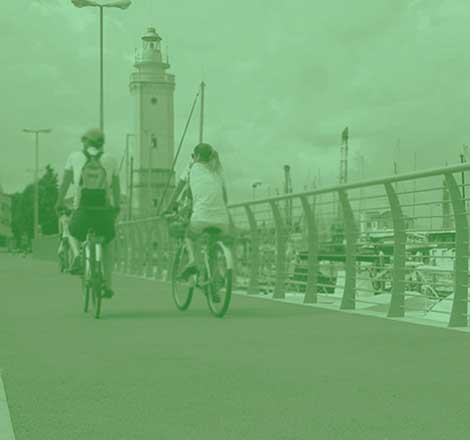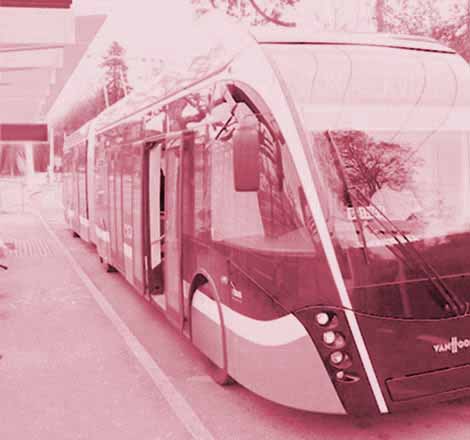THE “TRASPORTO RAPIDO COSTIERO” PROJECT
In a broader definition of the intervention of “transport system with restricted driving in the metropolitan area of the Romagnolo Metropolitan Coast”, is part of the first program of strategic works at national level identified by CIPE resolution no. 121 of 21.12.2001 (G.U. n.51 of 21.03.2002) implementing the Law 21.12.2001 n. 443 (so-called Objective Law).
The project was approved by the Interministerial Committee for Economic Planning (C.I.P.E.) with approval no. 93 of 29.03.2006 for a total economic framework of 92.053 million euros financed for 60% by the State Administration and for the remaining 40% by the Local Authorities subscribing to the Program Agreement for the construction of the work (Emilia Romagna Region, Province of Rimini, Municipality of Rimini, Municipality of Riccione and Cultural Heritage Province of Rimini). The latter has been identified as the subject of the actuator and the contracting authority.
The work, conducted by a J.V composed by Italiana Costruzioni Ltd. for the civil part and Alpiq Ltd. for the part of the traction machinery, were delivered in January 2013 and were completed as scheduled. The operating aid systems are made by Project Automation Ltd while the rolling stock is supplied to the J.V composed of Kiepe Electric, Kiepe Electric GmbH and Van Hool.
The vehicles will be delivered after summer 2019.
The facilities are completed and all facilities will be tested soon.
Procedures are in progress to obtain all the authorizations relating to the opening of the service to the public with the competent ministerial offices.
The 9.8 km long track connects the railway stations of Rimini and Riccione and is interspersed with 15 intermediate stops. The route is in part a double route (a 7.30m section) and partly single (a 4.20m section); the crossing of vehicles for single-track sections is always scheduled to stop.
The operating scenarios include:
• Rimini-Riccione 23 minutes travel time;
• 10-minute frequencies (5 vehicles in line) with upgrades of up to 7.5 minutes (8 vehicles in line);
• Maximum speed of 70 km / h;
• Acceleration and deceleration values in operation of 1m / sec2;
• Commercial speed of around 26km / h.
CIVIL WORKS
The track is entirely and exclusively in its own protected site, segregated throughout the installation of restraint devices (new jersey type). For the insertion of the infrastructure in the urban structure of the municipalities of Rimini and Riccione it was necessary to construct;
4 new driveway underpasses to replace the level crossings of the Bologna – Ancona railway line,
3 new cycle-pedestrian underpasses,
9 renovations with extension of cycle-pedestrian underpasses to the existing railway embankment,
9 underpasses for bypassing the transversal roadways to the Via di Corsa,
2 bridges for crossing watercourses,
7 box bridges for the bypassing of small streams and irrigation ditches.
Along the route there are 4 traffic circles, of which two at the end of the Rimini FS and Riccione FS terminus for the U-turn at the end of the single runs and two intermediates (FERMATA TOSCANINI – Via Chiabrera area and FERMATA MIRAMARE STATION – Via area Cavalieri di Vittorio Veneto) which divide the route into three homogeneous stretches for eventual partial runs and for entry / exit of vehicles.
The elimination of all interference with the network of urban services and sub services, the modification of the railway facilities near the Rimini and Riccione stations and the rebuilding of the current coded automatic blocking system along the line will complete the interventions.
TRACTION MACHINERY
The infrastructure has its “engine” in a traction system of a trolley-like type in continuity with the historic line 11 in operation since 1939. The machinery is equipped with 3 cabins of 15 kVca / 750 Vcc electrical transformation, remote controlled, with a double electric transformation group each of 890 kVA capable of guaranteeing the necessary powers for the operation of the TRC system in the various operating scenarios. The intermediate traffic circles of the Toscanini and Miramare Station stops will allow the traction system to be divided into three electrically independent sections through disconnectors with charged opening. The contact line will be powered at a nominal voltage of 750 Vdc made up of electrolytic copper conductors (CuAg0.1% silver copper alloy) with a cross section of 102 mmq positioned at an average height of 5.0 meters from the road surface. The contact line will be supported by pile-driven steel with a variable pitch between 27 and 33m and a self-tensioning suspension system (so-called “flexible”). The directionality of the transport system will be guaranteed in the intermediate traffic circles of Chiabrera and Cavalieri di Vittorio Veneto by convergent and divergent exchanges in a continuous line.
OPERATIONAL MACHINERY AID
The transport system is equipped with operating aid systems remotely controlled by a central control post and whose telecommunications network travels entirely on optical fibre. The overall safety level of the system is SIL 3, the level required by tram systems. The equipment is composed of the signalling system for the management of the operation along the single-run sections and the system for locating and controlling the operation in order to allow the intersections of vehicles , only when stationary.
The signalling of the vehicle at the extremities of the routes with a single runway takes place with a double system of turns (transmission turns capable of establishing a bi-directional communication with the board apparatus and electro-inductive mass coils) which activate the devices of light signalling (beacons stop / go and planned at the stops at pedestrian traffic crossings). The localization and control system of the exercise is guaranteed by a short-range inductive communication system from the transmission coils present at the stop and by the on-board GPS system that allows the localization in areas outside the stop zones. The systems for operating aid are completed by the audio / video system through variable message panels for user information, the system for the diffusion and communication of audio and video surveillance at stops, including the emergency stations for calls to the centre.
ROLLING STOCK
The ExquiCity18T vehicle developed by the Belgian company Van Hool and the German company Kiepe Electric GmbH is a two way vehicle axis (length 18.50 m), 2.55 m wide, with a lowered platform as to stop on level with the platforms. The trolley-driven vehicle is equipped with a 240kW electric motor and works autonomously with a group of a double pack of lithium titanate batteries with a power output of 49 kW for journeys outside the protected route. The Equicity18T is compatible and is able to use the optical assisted driving system of the Siemens Matra company to facilitate the slowing down phases at the waiting platforms currently in operation in European countries and, in Italy, in the system at Bologna.
The vehicle is also equipped with an operating aid system made up of on-board electronic devices capable of interfacing with ground-based installations to guarantee the regularity and safety of the operation in single-lane sections. As part of the improvement of the accessibility and usability features of the public transport as part of the intermodal policies between the different forms of transport and incentivisation of slow mobility, technical solutions will be developed that will allow access on board for commuters and their bicycles . In agreement with the Service Manager and with the approval of the competent offices of the Ministry of Infrastructure and Transport – General Directorate for Local Public Transport, suitable devices will be developed for carrying bicycles on board.









